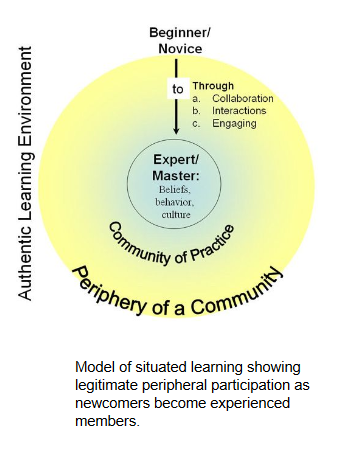Situated learning in practice

The concept of situated learning suggests that learning takes place through the relationships between people and connecting prior knowledge with authentic, informal, and often unintended contextual learning. For example, real world examples of situated learning may include teaching placements where students are immersed and active within an actual classroom environment or sports practice which may replicate an actual game.
In the context of teacher education, online learning communities allow a merge of real and virtual worlds as participants engage in discussions about real practice in the virtual world. The learning process and some of the tools they are using are embodied in the virtual world, however the participants themselves and the artefacts they were creating and using are very much located in the real world. The online community represents a continual crossover between these two spheres (Burnett, 2016).
This links with CoP ideas which suppose knowledge acquired in the virtual world can be applied in the real world. Online learning communities offer teachers the opportunity to make meaning from the engagement with other educators. They engage in a cycle of knowledge building through online social interactions followed by transfer to classroom practice. Context is therefore important: as learners use new skills in their familiar contexts and adapt them to relevant subject areas, the learning becomes authentic, directly relevant to their own classroom practice and the culture within it. (Brown et al. 1989).
Read more about situated learning here: http://hlwiki.slais.ubc.ca/index.php/Situated_learning_theory
Image source:
Shared by S Harvey, West Virginia University: https://www.slideshare.net/stharvey/models-of-supervision-reflection
References:
Brown, J.S., Collins, A., & Duguid, P. (1989). Situated cognition and the culture of learning. Educational Researcher, 18(1), 32-42.
Burnett, C., 2016. Being together in classrooms at the interface of the physical and virtual: implications for collaboration in on/off-screen sites. Learning, Media and Technology, 41(4), pp.566-589.
Collins, A. (1988). Cognitive apprenticeship and instructional technology. Cambridge, MA: BBN Labs Inc.

